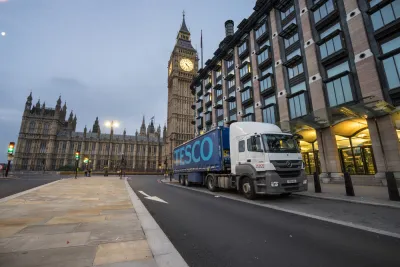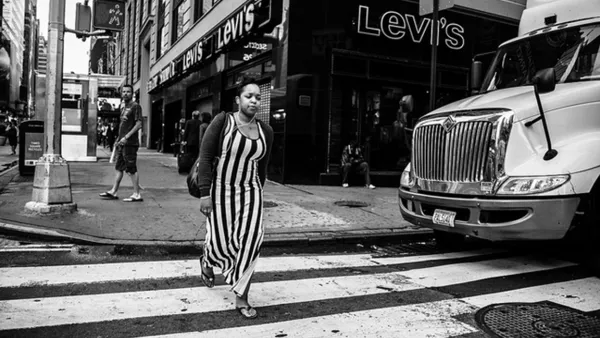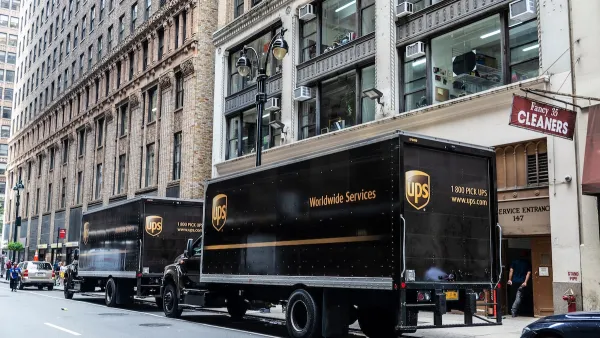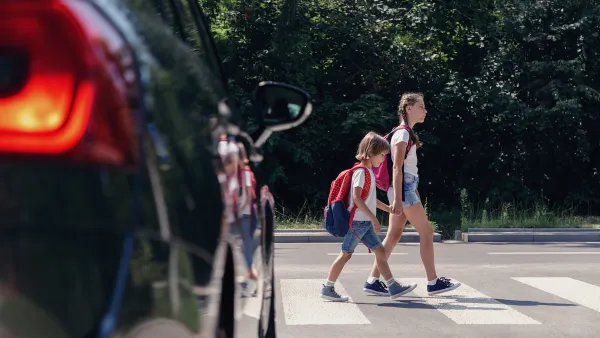The goods movement industry wants a seat at the table.

By Karl Vilacoba
A delivery man pulled and pushed for min-utes on end but couldn’t get his hand truck over the extra high curb. Upon one last try, the frustrated worker’s shipment—a heavy keg of beer—tipped over and rolled into the downtown Washington, D.C., roadway.
At a restaurant across the street, Tom Madrecki watched the episode unfold and considered all of the potential ramifications—safety issues, damaged goods, traffic holdups—which could have been avoided if the curb were a few inches shorter.
American planners spend countless hours mulling how to solve the last-mile question in their cities. But Madrecki’s employer, the world’s largest shipping company, the United Parcel Service (UPS), is concerned above all with the last 50 feet.
“It’s that last 50 feet of the trip where so much can happen, and a lot of things taking place on the city’s side are impacting UPS,” Madrecki, a spokesman for the company, said.
The goal of complete streets policies and improvements is to make streets accessible for all users. In practice, it usually means making car-oriented roads safer for bicyclists and pedestrians. However, complete streets design changes — such as narrower roads and bike lanes—are often the exact opposite of what makes life easier for a truck driver.
Opposing market forces are making the conflicts more pronounced. On one hand, real estate trends nationwide have swung in favor of living spaces in urban cores or downtown areas where residents can walk to stores, restaurants and nightlife. At the same time, the e-commerce revolution has put retail spaces out of business and brought about a surge in deliveries to dense neighborhoods that was never planned for.
How big? According to Alison Conway, a freight policy and logistics expert with the Department of Civil Engineering at the City College of New York, recent research in Fort Lee, New Jersey, found that each residence received about 1.5 packages per week. That means the town’s high-rise apartment buildings overlooking the Manhattan skyline can generate in the neighborhood of 2,000-3,000 deliveries per week.
That said, goods movement experts from around the country say that freight and complete streets are more than compatible. They offered the following food for thought for planners and policymakers as they craft complete streets policies and gear up for road improvement projects.
FULL STORY: Factoring Freight into Complete Streets Plans

Analysis: Cybertruck Fatality Rate Far Exceeds That of Ford Pinto
The Tesla Cybertruck was recalled seven times last year.

National Parks Layoffs Will Cause Communities to Lose Billions
Thousands of essential park workers were laid off this week, just before the busy spring break season.

Retro-silient?: America’s First “Eco-burb,” The Woodlands Turns 50
A master-planned community north of Houston offers lessons on green infrastructure and resilient design, but falls short of its founder’s lofty affordability and walkability goals.

Test News Post 1
This is a summary

Analysis: Cybertruck Fatality Rate Far Exceeds That of Ford Pinto
The Tesla Cybertruck was recalled seven times last year.

Test News Headline 46
Test for the image on the front page.
Urban Design for Planners 1: Software Tools
This six-course series explores essential urban design concepts using open source software and equips planners with the tools they need to participate fully in the urban design process.
Planning for Universal Design
Learn the tools for implementing Universal Design in planning regulations.
EMC Planning Group, Inc.
Planetizen
Planetizen
Mpact (formerly Rail~Volution)
Great Falls Development Authority, Inc.
HUDs Office of Policy Development and Research
NYU Wagner Graduate School of Public Service




























